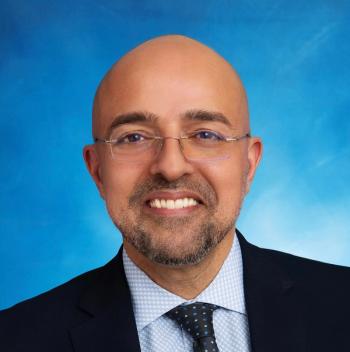
The Complicated Ethics of Gene Editing
How can healthcare discuss and deliver cutting-edge treatments without violating patients’ rights?
A few times a month, Johnny Kung, Ph.D., and his colleagues sit down with groups of people to tell them about all the different ways they could have been born. Kung works for Harvard University’s Personal Genetics Education Project (pgEd), an outreach group that talks to classrooms, churches and healthcare professionals about the potential of gene-editing technology — and about the ethical dilemmas it presents.
When Kung approaches a class, he can’t shy away from the transformative, and possibly transgressive, nature of his field. Gene editing could give doctors the ability to change the building blocks of human life, overhauling everything from our susceptibility to diseases to our physical strength and stamina. It promises cures for cancer, hereditary disease and any number of genetic flaws that cause hardships. But like our bodies, the world is an imperfect place, and some groups think altering our fundamental code is problematic, for many reasons.
>>
Our understanding of the human genome, and what editing it might produce, remains far from complete, and opponents worry that beginning to change it will have unforeseen and disastrous side effects. Others worry that creating a system in which humans can enhance themselves will further societal divides between the haves and have-nots, allowing only the rich to change their genes and futures.
Kung accepts this. But he also realizes that personal genetics are only going to play a larger role in personal health and society in the future — and the only way to maximize their potential and minimize their pitfalls is to empower the public to make thoughtful, informed decisions. Techniques like CRISPR/Cas9, short for clustered regularly interspaced short palindromic repeats, and chimeric antigen receptor T-cell (CAR T) therapy are still in their infancy but have already shown groundbreaking results in animal and human trials. As these innovations develop, healthcare providers must learn how to counsel patients, navigating the ethical intricacies of changing the human body among different groups, races and religions.
“For many of the communities we engage with, genetics is so closely tied to questions of health, identity, autonomy and privacy, informed consent and history,” Kung says. “We believe that having these difficult conversations early and frankly is important for our audience to be informed.”
Epigenetics’ Unethical History
Kung says his team’s goal is to “spark conversations about what ways these communities can ensure that current research in these areas can lead to benefits for their communities while preventing the negative history from repeating.” Usually, Kung goes into a classroom or a community center with a short lecture, orienting people to the basics of what gene editing is. After some PowerPoint slides, he likes to pose different scenarios or ethical dilemmas to the group and have them sort themselves into smaller groups based on their stance. This helps them solidify arguments and process why they hold their own views and why others might feel differently. Trying to decide the future of the human race can get thorny, and for many historically marginalized groups, the scientific advancements have often come at the expense of violence to their communities. Many communities just don’t trust scientists who promise miracles.
In 1932, the U.S. Public Health Service performed a
In 2016, Kung met with a group of black pastors in Baltimore for a conference co-organized by the
“One of the pastors who was in attendance told us bluntly that, to many of them, Harvard [where the pgEd is based] carries the same connotations as their local medical powerhouse, Johns Hopkins — a history of mistrust, the story of Henrietta Lacks,” Kung says.
Much of modern cancer treatment stems from the cell line of Lacks, a black woman whose biopsied cancerous cells were immortalized by doctors at Johns Hopkins in 1951. Lacks never consented to the procedure nor received any compensation for the invaluable research that resulted from her genetic material. Though her body has saved countless lives and changed the way we understand humanity’s most dangerous disease, she was effectively used as a laboratory specimen by doctors entrusted with her care. Lacks, the Tuskegee experiment and a
Citing the history of eugenics, critics of gene editing warn that editing of individual human embryos could quickly become a tool of oppression. They fear that bad faith actors wielding complete control of the human genome could carry out genocide or systematic oppression on an unprecedented scale.
Even in a best-case scenario, the ability to edit embryos, like
Marcy Darnovsky, executive director of the Center for Genetics and Society and one of the most outspoken critics of gene editing of most forms, says that CRISPR technology and other epigenetic procedures could quickly make Silver’s dystopia possible.
>>
This fear is particularly pronounced in one specific kind of epigenetics, a process called germline editing. Germline gene editing changes the genetic makeup of something while it is still in embryo, ensuring that the resultant life form will pass on those changes to their own offspring. In humans, germline editing immediately changes a person’s genome, and thus their life, before they are a conscious being capable of consent or awareness of what’s happening. With a germline change, doctors or scientists could, for example, eliminate the chance that a baby would be born with Huntington’s disease or another hereditary condition. But the fear is that things go further: that genetic treatments become an expensive luxury that one class of people can afford so that all children born to the wealthy will be stronger, taller, smarter and healthier than those who cannot afford treatments.
“This kind of thing could take us to some very ugly places,” Darnovsky says. “We already tolerate pretty huge levels of inequality and unfairness in this society that we have. And I think that to try to add to that, exacerbate that, just seems wrong.”
The Future of Gene Editing
Make no mistake: Gene-editing technology is here. Public and private labs across the country are throwing money and resources into genetic research and CRISPR trials, and it’s inevitable that, eventually, many of the changes that critics worry about will become possible. But that doesn’t mean this scientific evolution has to play out the way that Darnovsky and others fear.
CRISPR technology can be used both for germline editing and somatic editing, which refers to changing the genes of living cells in a fully formed organism to fight cancer or genetic disease or to provide other enhancements.
Somatic gene editing with CRISPR most recently
>>
Germline and somatic editing are being widely researched in both humans and animals despite the ongoing debate. Even so, in 2015, the National Institutes of Health (NIH), a major government source of funding for scientific trials, announced that it would not fund germline gene-editing experiments on human embryos.
“The concept of altering the human germline in embryos for clinical purposes has been debated over many years from many different perspectives and has been viewed almost universally as a line that should not be crossed,” NIH Director Francis S. Collins, M.D., Ph.D.,
Germline editing of human embryos is legal but must be privately funded, a regulation that has been on the books well before CRISPR became prominent: The 1996 Dickey-Wicker Amendment prohibits the creation or destruction of human embryos during any research that uses federal funding. Other countries, such as the U.K. and China, have less restrictive laws: Chinese researchers reportedly used CRISPR to genetically modify human embryos as far back as 2015.
Still, experts say that it’s unlikely germline-editing techniques will make it into a clinical setting in the near future.
“We don’t even know how well CRISPR is going to work as a way to treat disease in living patients, so it’s really too early to think about doing this clinically in embryos,” Sternberg says.
>>
CRISPR technology is not without risks, and with a scarcity of human trials, it’s still too early to tell how soon they’ll be clinically viable. In June, two studies
“We are at a very early stage of our understanding of how changing one genetic sequence might have biological and health consequences,” she says. “We just learned how to read the human genome a few years ago. If we try to rewrite it now, to rewrite the code, we’re likely to have some bugs.”
For doctors and scientists working on genetic treatments for disease, Sternberg explained that there’s an ethical difference between exposing a living patient to the risk of a procedure going wrong and exposing a future person to an unforeseen host of effects. A living patient may consent to a CRISPR treatment, knowing there’s a chance they’ll contract cancer, because they think it will give them the best shot at life. But an embryo and future offspring can’t consent to having their genetic code completely altered.
Fortunately, in our current medical system, germline editing is largely unnecessary to treat medical conditions.
“I think it’s going to be very rare that you’ll have medical needs that would justify germline editing,” Sternberg says. Instead, major companies pursuing CRISPR technologies on a clinical, commercial level —
The solution to this, and to some of the more ideological critiques of gene editing, Sternberg says, is to treat gene editing as any other medical procedure.
>>
“I think it’s often mentioned in this way as being a very profound thing,” Sternberg notes. “I don’t actually see intervention at the genetic level as something we should do any more or less seriously than intervention at a surgical level or in a way that might modify the genome of certain cells. The question is, can some intervention address medical needs? Can it be offered in an equitable, socially responsible way, and are there any safety concerns that may be intended or unintended that we need to address?”
And right now, somatic gene editing shows great potential to help. Novartis’
How the Healthcare Industry Can Adapt
What focusing on somatic, clinical applications of gene-editing technology doesn’t solve, however, is the social ethics component of the conversation. The applications for CRISPR tech are varied, from a cure to cancer to enhanced muscle tone. As the medical science community gains further understanding of the human genome, more solutions will present themselves and more cures will become available. Darnovsky worries that gene editing will become like cosmetic surgery, which was first proposed as a treatment for patients with disfiguring wounds but then became a luxury for those who could afford it. Except gene editing could create differences even more drastic than those of personal appearance — it could weed out diseases, improve life expectancies and change bodies. Those who will miss out on these advancements are the populations of people the existing medical system in the U.S. often overlooks: the uninsured or underinsured, the poor, ethnic minorities and rural populations living far from well-equipped, metropolitan healthcare networks.
Sternberg mentioned the case of sickle cell anemia, a chronic genetic condition that predominantly affects African-Americans. Sickle cell is virtually incurable, but there are treatments that have improved the life expectancy for many affected patients. And yet hydroxyurea, the most effective treatment for sickle cell, is
“If that isn’t available today, then what is going to be the landscape with a new, highly priced drug named CRISPR that’s even more difficult for most of these people to access or pay for?” Sternberg asks. “None of that excitement [about CRISPR] addresses these underlying problems with access and insurance.”
Sickle cell is one of many diseases that
Kung covered this on the second day of his meeting with church leaders last year. He was invited back to one of the pastors’ churches to speak more about the coming revolution of personal genetics. The pastors told Kung to focus on the technology’s potential to deliver patients from suffering rather than its comparisons to “playing God.” In Tuskegee, with Henrietta Lacks, researchers were playing God, with unwitting subjects unable to consent. With gene editing, that possibility is on the table, particularly if the technology is deployed in a way that only some have the means to use it.
Speaking to the pastors, Kung says, “showed us how wide the gap is between the biomedical research community and some of the communities it’s supposed to serve. And how much work still needs to be done to narrow this gap.”
Get the best insights in healthcare analytics
Related







































